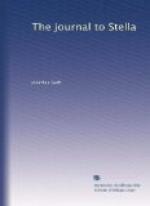6 No. 27, by Swift himself.
7 No. 7 of Harrison’s series.
8 The printers of the original Tatler.
9 Harley had forwarded to Swift a banknote for fifty pounds (see Journal, March 7, 1710-11).
10 At Moor Park.
11 Scott says that Swift here alludes to some unidentified pamphlet of which he was the real or supposed author.
12 See Letter 11, note 13.
13 The Examiner.
14 See Letter 6, note 43.
15 Mistaken.
16 Mrs. De Caudres, “over against St. Mary’s Church, near Capel Street,” where Stella now lodged.
17 “A crease in the sheet” (Deane Swift).
18 “In the original it was, good mallows, little sollahs. But in these words, and many others, he writes constantly ll for rr” (Deane Swift).
19 See Letter 4, note 19.
20 “Those letters which are in italics in the original are of a monstrous size, which occasioned his calling himself a loggerhead” (Deane Swift). [Italics replaced by capitals for the transcription of this etext.]
21 I.e., to ask whether.
Letter 16.
1 Harcourt.
2 “A shilling passes for thirteenpence in Ireland” (Deane Swift).
3 Robert Cope, a gentleman of learning with whom Swift corresponded.
4 Archdeacon Morris is not mentioned in Cotton’s Fasti Ecclesiae Hiberniae.
5 See Letter 14, note 6.
6 See Letter 10, note 2.
7 Abigail Hill, afterwards Lady Masham, had been introduced into the Queens service as bed-chamber woman by the Duchess of Marlborough. Her High Church and Tory views recommended her to Queen Anne, and in 17O7 she was privately married to Mr. Samuel Masham, a gentleman in the service of Prince George (see Letter 14, note 6). The Duchess of Marlborough discovered that Mrs. Masham’s cousin, Harley, was using her influence to further his own interests with the Queen; and in spite of her violence the Duchess found herself gradually supplanted. From 1710 Mrs. Masham’s only rival in the royal favour was the Duchess of Somerset. Afterwards she quarrelled with Harley and joined the Bolingbroke faction.
8 See Letter 4, note 16.
9 No. 14 of Harrison’s series.
10 See Letter 15, note 4.
11 Richard Duke, a minor poet and friend of Dryden’s, entered the Church about 1685. In July 1710 he was presented by the Bishop of Winchester to the living of Witney, Oxfordshire, which was worth 700 pounds a year.
12 Sir Jonathan Trelawney, one of the seven bishops committed to the Tower in 1688, was translated to Winchester in 17O7, when he appointed Duke to be his chaplain.
13 See Letter 4, note 3.
14 See Letter 3, note 39.
15 See Letter 14, note 14.
16 See Letter 7, note 28.
17 Cf. Feb. 22, 1711.




